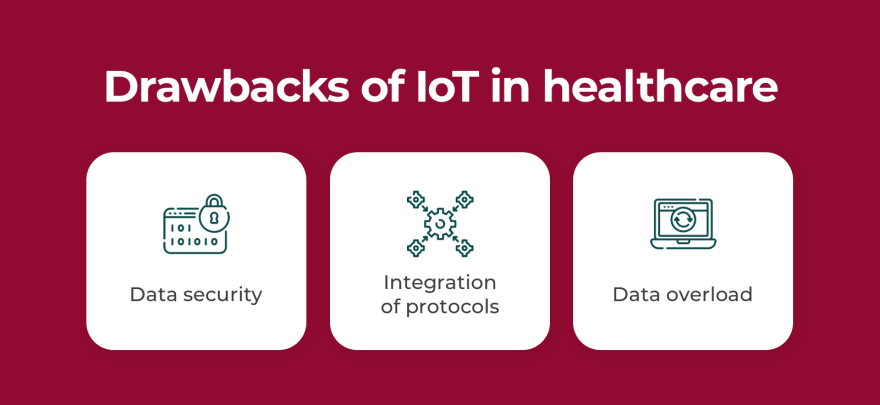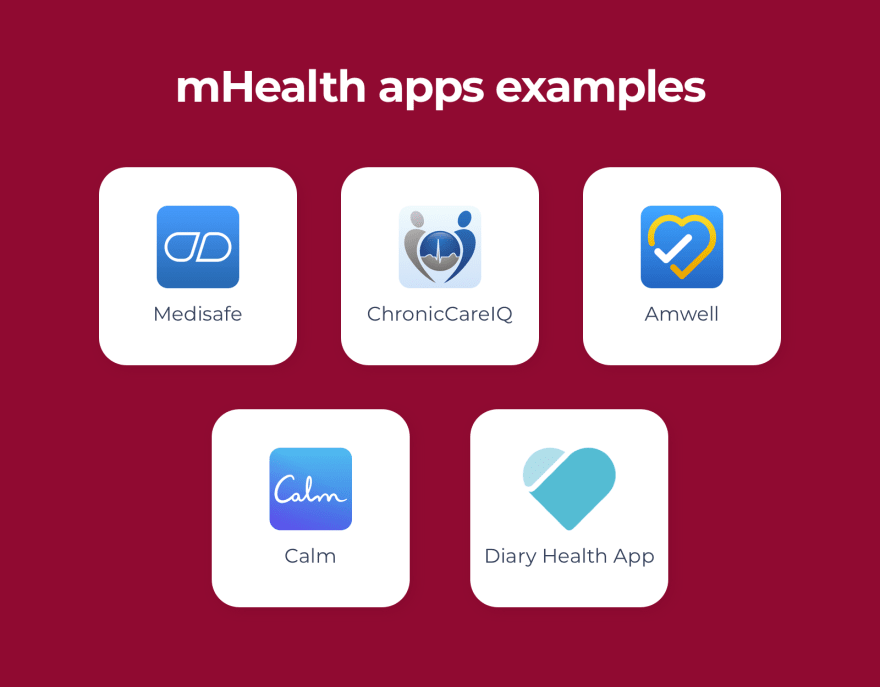The healthcare industry has become smarter with modern technologies. There are a bunch of cool innovations like robot-surgeons and smart hospitals. Due to IoT, patient care has reached a higher level. It allows optimizing workflows for healthcare providers, along with doctors.
Many hospitals have already invested in the integration of this technology. For instance, Saratoga Hospital invested in an IoT-based solution that allows monitoring patients’ conditions.
The Internet of Things technology helps doctors and patients, so it’s integrated into hardware and software solutions.
Why Healthcare?
The Internet of Things can be profitable for a lot of fields like e-commerce, logistics, and more. Why do we discuss healthcare? Because this industry offers a bunch of data sensors that improve in-patient treatment, prevent disease, and monitor health conditions.
IoT-based software for the healthcare industry can gather information from patients and process it automatically. As a result, it’s possible to detect precursors of disease and prevent its progression.
The statistics claim that the healthcare market can reach $534.3 billion by 2025.
Internet of Medical Things or IoMT
We’ve already mentioned that connected devices provide a bunch of opportunities in the healthcare field. It’s expected that the Internet of Medical Things (IoMT) will reach $136.8 billion by 2021.
So, let’s discuss what IoMT is and how this technology works.
According to Andrew Keller, IoMT stands for “devices that can collect and exchange data — either with users or other devices — via the Internet, and are used to allow doctors to be more aware of a patient’s condition on a real-time basis.”
IoMT tends to monitor the patients’ conditions and notify the doctors in case of an emergency.
The Internet of Medical Things consists of a lot of things like wearable devices, drug trucking systems, remote patient monitoring, and others.
This powerful technology increases the accuracy of diagnoses due to constant tracking of health changes. IoMT-based apps allow patients and doctors to stay in touch with each other. Additionally, the working process becomes more effective for doctors that take care of many patients.
Why Use IoT in Healthcare: Top Five Main Benefits
There are a lot of advantages of using the Internet of Things technology for the healthcare and medical fields. We’ve singled out the most valuable benefits to discuss them in detail.
Benefit #1. Health Monitoring
There are a bunch of cool smart devices that constantly track health conditions. Also, IoT apps can send emergency signals in the case of an asthma attack, heart failure, and other medical issues.
For instance, Apple has integrated a Fall Detection System in Apple Watch. It detects if the person falls and shows an alert on the screen. The user has to tap ‘I’m OK’ for one minute. In another case, the system calls the emergency services and tells the users’ location. Apple watch also sends a message with the location to emergency contacts.
Benefit #2. Improved Patient Experience
The Internet of Things allows improving the healthcare systems in hospitals. Also, this technology provides a convenient way for patients to stay in touch with doctors. Of course, it leads to better customer experience. The patients trust such hospitals.
For example, the hospital in New York, the USA — Mt. Sinai Medical Center — has reduced the waiting time for 50% of their emergency patients with the help of AutoBed software.
How does the system work?
The hospital has about 1,100 beds, but they have at least 59,000 patients. AutoBed manages available beds with new patients.
Benefit #3. Drug Management
IoT brings a bunch of improvements to drug management. The Internet of Things technology allows tracking the amount of taken medicine. As a result, doctors can see the dose and monitor the effectiveness of treatment. Additionally, it’s easy to change the dose in case of an emergency.
One more benefit of this technology is an opportunity to send notifications. How does this work? IoT sends push notifications when a patient has to take drugs. Also, the system can notify family members if the patient hasn’t taken the required medicine on time.
For example, there is a solution called FindAir. It was created for patients who are suffering from asthma. The patient has an inhaler with medicine and an app on the phone. The app sends push notifications if the user forgets the inhaler.
Benefit #4. Healthcare Automation
There are a bunch of IoT devices that allow the automation of administrative, manual, and routine tasks. The Internet of Things technology tends to analyze a lot of information to create various statistics. For example, different metrics allow seeing any changes in the patients’ health conditions.
The process of automatics data collection saves time and reduces the number of mistakes in making diagnoses.
Benefit #5. Preventive Healthcare
A bunch of people die from chronic diseases such as heart disease, diabetes, and more every day. Using the analytic capabilities of IoT, it’s possible to offer patients more personalized forms of treatment and care. It leads to better treatment results.
Also, there are a lot of Smart, Connected or Wearable devices that tend to monitor the health conditions of elderly or patients with chronic diseases. Having all the information about their health conditions, doctors will be able to give an improved treatment and see the first symptoms of the disease.
As a result, they can prevent diseases instead of treating them.
What Are the Drawbacks of Using the Internet of Things in the Healthcare Industry?
Having listed the advantages of IoT in healthcare, we can claim that this technology revolutionizes medicine. However, there are several pitfalls that we can’t ignore.
To give you a hint, we’ve listed some of them below.
Pitfall #1. Data Security
The primary problem of IoT for healthcare is the lack of security. The medical sector uses a lot of personal data that has to be protected properly.
Patients share with doctors confidential information. In the case of leaking information, healthcare organizations will face a bunch of government issues in addition to losing patients’ trust.
How to avoid such situations? Creating an IoT-based software, you need to consider security issues. Of course, it leads to additional expenses.
Additionally, you need to keep in mind two government requirements that protect the patients’ personal data — GDPR and CCPA.
- GDPR. General Data Protection Regulation stands for regulations that allow EU citizens to control their data. To comply with GDPR, you need to create internal politics of data protection, train staff, and verify processing data activity.
- CCPA. California Consumer Privacy Act stands for the law that provides consumers with more control over their private information. Complying with CCPA is essential for medical software.
What is the difference between CCPA and GDPR?
GDPR regulates human private rights across Europe. Due to this law, websites have to show warnings about cookies files, data protection agreements, and so on. GDPA is obligatory for any business that uses personal data.
As for CCPA, this regulation is obligatory only for ‘for-profit companies’, businesses that get revenue more than $25 million.
Additionally, GDPR covers more parts of personal data, like any health-related information.
Pitfall #2. Integration of Protocols
The Internet of Medical Things tends to connect a bunch of various devices like phones, smartwatches, fitness trackers, and so on. In order to make a flexible ecosystem, it’s required to use the functionality of a lot of devices with various protocols.
Unfortunately, there is no single solution for communication protocols and standards. So, it’s complicated and slow to integrate the Internet of Things technology in the healthcare sector.
There is one more drawback. Medical software has to comply with HIPAA and HITECH protocols. They tend to contain a lot of rules and regulations that allow processing the personal information of the patients.
- HIPAA. The Health Insurance Portability and Accountability Act tends to manage the flow of personal data of the patients and protect information from fraud and theft. To comply with HIPAA requirements, you need to consider such tech aspects as access control, encryption and decryption data algorithms, automated log-off, and so on.
- HITECH. The Health Information Technology for Economic and Clinical Health Act expands the HIPAA requirements. For example, patients get access to their Protected Health Information online.
Pitfall #3. Data Overload
We’ve already mentioned that IoT-based devices collect and process a lot of patients’ information. It can lead to data overload for doctors and accuracy issues.
The enormous amount of data can make the process of making decisions more complicated. As a result, doctors can make errors in making the diagnoses.
Ways to Use IoT in the Healthcare Field
MarketWatch claims that the Global Internet of Things in the healthcare industry is expected to grow at a valuation of about $162.2 billion by the end of 2024.
IoT in the healthcare and medical sectors allows saving time and improving customer experience. Additionally, it increases the diagnosis accuracy. Of course, a lot of enterprises like Apple and Google constantly invest in this technology.
There are a lot of devices like Apple Watch and Fitness Bands that measure users’ heartbeat.
We’ve decided to discuss the most promising use cases of the Internet of Things for healthcare. Additionally, we’ll talk about existing solutions in the modern market.
Use Case #1. Hospital Information Management System or HIMS
The Internet of Things has brought a bunch of cool changes to hospital management systems. For instance, these days, HIMS can collect and manage such data as medical records of the patients, information about doctors, and their qualifications. Additionally, the system offers access to up-to-date data about appointments, free hospital rooms, and more.
Let’s single out several benefits of HIMS to the healthcare field:
- Faster search of documents;
- Remote access for doctors to patients’ records;
- Better security;
- Drug management;
- Better patient experience.
A lot of companies have already developed a Hospital Information Management System, so that you can use a ready-made solution. These systems provide access to information from various devices.
To give you a hint, we’ve listed several huge market players:
- eHospital
- eVisit
- myNapier
- Insta HMS
Use Case #2. Electronic Healthcare Records System or EHR
One more way to use IoT in healthcare is EHR systems.
EHR means electronic health records. These systems allow providing real-time data instantly and security to the users — both doctors and patients.
Electronic Healthcare Records System brings a bunch of benefits to the healthcare sector for end users. For example, doctors have access to the latest tests of the patient. Also, it’s possible to look through the full disease history.
Additionally, patients can get in touch with medical workers 24/7. That’s especially important for patients with chronic diseases like diabetes or asthma.
Use Case #3. Mobile Healthcare
It’s common to use mHealth applications to increase customer experience. IQVIA claims that the App Store and Google Play have more than 320,000 mHealth applications.
Such apps are convenient since they offer a bunch of opportunities like getting a consultation with doctors online, scheduling offline meetings, and looking through the latest tests.
There are two primary types of IoT applications for the healthcare industry — for emergency or regular treatment.
Also, there are applications connected to wearables. Such solutions tend to collect data about the physical activity or health conditions of the users. IoT-based apps for wearable devices can transfer data to the smartphone.
mHealth apps can be divided into the following types:
- Meditation apps
- EHRs
- Apps for tracking sleep
- Fitness apps
Let’s consider an example. One of the most popular mHealth solutions for mental health is Calm. This solution is available on iOS, Android, and web, offering users many exciting and useful features.
For example, the app has a lot of guided meditations that help clear the mind. The user can set the duration of the meditation, according to the users’ free time and wish. Also, there are video lessons on mindful movements and gentle stretching.
Additionally, Calm has a user-friendly and intuitive design. There are no bright colors. Designers used a natural palette of pastel shades.
Use Case #4. Wearable Devices
The stats are quite promising: by the end of 2021, the market of wearable software will reach about $62 billion.
The market is full of various wearable devices like smartwatches, fitness trackers, smart jewelry, and others. All of them have similar functions but different designs, so it’s easy to choose a device that fits your style.
The primary feature of wearable devices is health data collection. Users wear such devices all the time, so it’s easy to track such health marks as heart rate, steps, burned calories, blood pressure, and more.
One of the most popular gadgets on the market remains Apple Watch. This device from Apple has challenging Activity Rings. The user needs to close all the rings during the day.
There are three rings: Move, Exercise, and Stand. The Move ring is red. Users set the personal goal of active calories burned. The Exercise ring is green. To close it, users should have at least 30 minutes of activity. As for the Stand or blue ring, customers need to get up and move around for at least one minute during twelve different hours in the day.
Such a system motivates users. Also, there are a lot of rewards for your achievements.
Use Case #5. Remote Health Monitoring
Special IoT healthcare devices and software solutions allow treating patients remotely. For example, telemedicine offers doctors to communicate with patients in case of an emergency.
What is telemedicine?
Telemedicine stands for a method of delivering healthcare services to patients remotely. Users need to have three main components to start using telehealth:
- Custom software
- Camera
- Microphone
Telemedicine app development brings the following advantages to the healthcare industry:
- Reduced healthcare expenses;
- Time-efficient treatment;
- Easy way to get in touch with doctors;
- Reduced waiting time.
Of course, there are more ways to use the Internet of Things technology in the healthcare industry. For example, a lot of devices can offer medical care considering all individual demands of each patient using IoT healthcare sensors.
As you can see, the Internet of Things technology is quite profitable for the healthcare field. It allows offering patients better services.
There are a bunch of solutions that track healthcare data. It allows doctors to make a more accurate diagnosis.
IoT-based solutions are perfect for treating patients with chronic diseases. The doctors can monitor their health conditions and any changes.










Top comments (0)